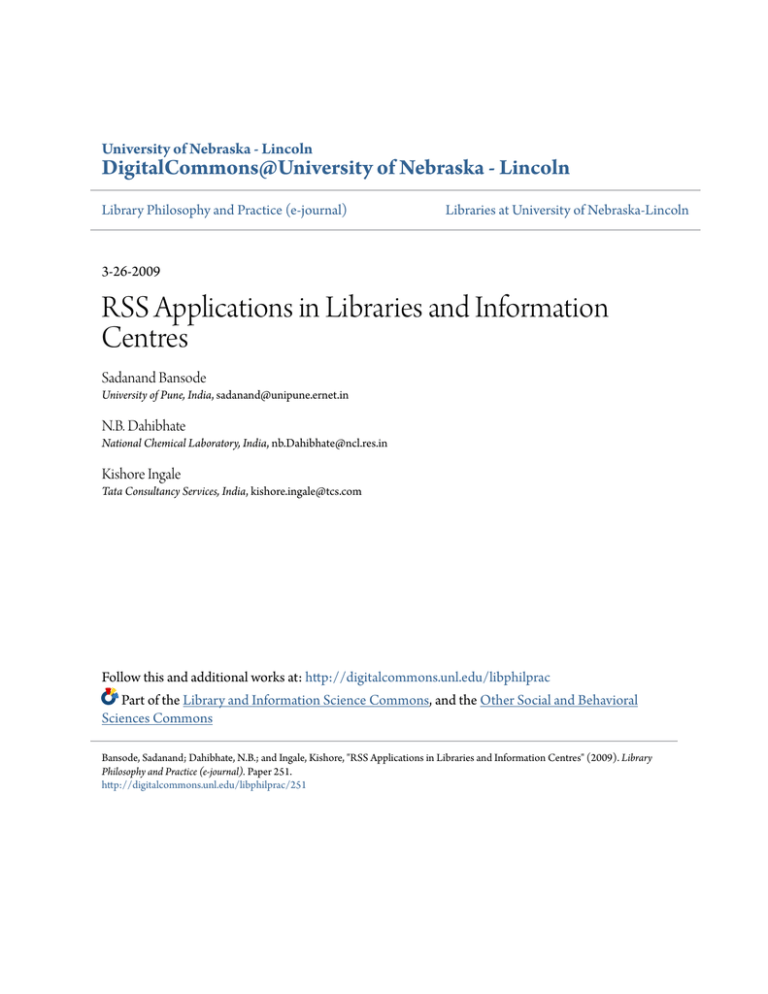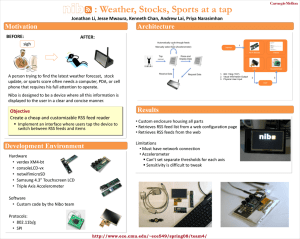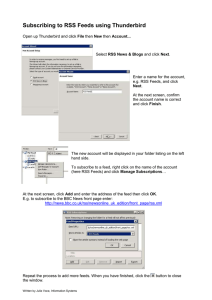RSS Applications in Libraries and Information Centres
advertisement

University of Nebraska - Lincoln DigitalCommons@University of Nebraska - Lincoln Library Philosophy and Practice (e-journal) Libraries at University of Nebraska-Lincoln 3-26-2009 RSS Applications in Libraries and Information Centres Sadanand Bansode University of Pune, India, sadanand@unipune.ernet.in N.B. Dahibhate National Chemical Laboratory, India, nb.Dahibhate@ncl.res.in Kishore Ingale Tata Consultancy Services, India, kishore.ingale@tcs.com Follow this and additional works at: http://digitalcommons.unl.edu/libphilprac Part of the Library and Information Science Commons, and the Other Social and Behavioral Sciences Commons Bansode, Sadanand; Dahibhate, N.B.; and Ingale, Kishore, "RSS Applications in Libraries and Information Centres" (2009). Library Philosophy and Practice (e-journal). Paper 251. http://digitalcommons.unl.edu/libphilprac/251 Library Philosophy and Practice 2009 ISSN 1522-0222 RSS Applications in Libraries and Information Centres Dr. Sadanand Bansode Reader Dept. of Library & Information Science University of Pune Pashan Road, Mumbai, India N.B. Dahibhate Information Scientist National Chemical Laboratory Pune –7 India Kishore Ingale Information Manager Tata Consultancy Services Pune – 8, India Introduction The use of Information and Communication Technologies (ICTs) has had a profound impact on library and information science. Advances in ICTs have allowed traditional LIS methods to be replaced by the newer, faster, and more accurate ways of transmitting information. Library automation, database development, networking of libraries, Internet and intranet applications in LIS, consortium-based benefits, and so on, have benefited librarians and library users for a number of years, making the work of libraries easier and more user-based. Web 2.0 applications are carrying these trends further. Blogs, for example, are now widely used in libraries (Davison-Turley, 2005). Blogs are more powerful with the help of tools like RSS. What Is RSS? The initials RSS stand for several things: Rich Site Summary (Myadbase 2007) Really Simple Syndication (Chrsolutions 2007) RDF Site Summery (Mason 2007) RSS is an XML application that allows users to gather content as it is created and as sites are updated. When such a web feed is created, interested users can subscribe to it (Holvoet, 2006). Syndicated web pages are viewed with feed readers. RSS distributes a list of headlines, update notices, and sometimes full-text content. 1 “RSS Applications in Libraries and Information Centres,” Dr. Sadanand Bansode, N.B. Dahibhate, Kishore Ingale. Library Philosophy and Practice 2009 (March) Literature Review Ingram and Awre (2005) review the literature on RSS, including its use as a portal (Clark, 2001), a way for librarians to evaluate and recommend websites (Spence, 2004), a way of filtering and customizing information delivery (Arnold, 2004), and a means of viewing relevant information in a succinct format (Moffat, 2003; Hammond et al., 2004). They discuss the literature on blogging and RSS, including Conhaim (2004), and the use of RSS with harvested metadata (Duke, 2003). RSS Uses and Functions Without RSS, users must check needed sites daily for updates. An RSS feed (often called a news feed) can check sites using an RSS aggregator (a program that gathers and sorts out feeds). Since RSS data is small and fast-loading, it can easily be used with services like cell phones or PDAs (w3schools, 2008). RSS uses XML to distribute web content from one web site to many other sites. RSS feeds are RDF-compliant, and RSS files contain metadata that describes the content (James, 2000) A website that wants to allow other sites to publish some of its contents, create an RSS document and register the document with RSS publisher. Syndicated data can contain data like news, event listings, news stories, headlines, project updates etc. The special XML-format file that makes up an RSS feed is usually created in variety of ways. News sites and blogs are maintained using content management systems that often create RSS feeds as they are updated. Websites produced with tools like Dreamweaver generally do not create feeds automatically. Figure 1 shows how websites, the RSS feed XML files, and computer are connected: Figure 1: RSS Feed (Source :http://rss.softwaregarden.com/aboutrss.html) RSS is useful for websites that are updated frequently such as those of news sites, corporations, calendars, database producers, and libraries and information centres. Considerations for Libraries Libraries should consider whether the information contained in a feed meets the needs of the user, and whether obtaining the information via a feed from the publisher will help to compact and provide focused information to users. Not all information is offered through a feed. It may be necessary to 2 “RSS Applications in Libraries and Information Centres,” Dr. Sadanand Bansode, N.B. Dahibhate, Kishore Ingale. Library Philosophy and Practice 2009 (March) subscribe to the resource in order for the feed to be useful. Feeds should be updated frequently and expiration dates should be considered. Copyright is another issue to consider (Hart, 2007) Library Web Feeds Libraries are increasingly creating feeds to promote and services. Libraries that offer web feeds for announcements include: Georgia State University Library Lunar and Planetary Institute, Center for Information and Research Services Minneapolis Public Library Northwestern University Library Ohio University Libraries Rowland Institute at Harvard Library Suburban Library System University of North Carolina at Chapel Hill Libraries University of Windsor, Leddy Library (McKiernan, 2004) Application of RSS Feeds in the Library There are various RSS feed applications for libraries. Wusteman (2004) lists and describes them, including announcements, extended services, e-journals and table of contents services, reference service, library blogs, web resource announcements, search resource, books, newsgroups, search results, and RSS-based search engines. Advantages and Disadvantages For information producers, advantages include increasing web traffic, easy updating and dissemination of information, and efficiency for webmasters. For web content managers, there is delivery of targeted information and value-added services. For information users, there is control over the flow of information, easy sharing, and a more efficient delivery method. Disadvantages include the fact that not every site has a feed. Some feeds expire after a specific time period. RSS content may not be being fully used, and there may be copyright issues. Librarians must apply selection criteria and evaluate resources to reduce irrelevant results. The Future of RSS RSS will probably be even more prevalent in the future, making information easier to find. Browsers are beginning to include RSS features and plug-ins. Portals targeted to specific interests and subjects are being developed. For libraries, RSS feeds provide a way to disseminate or publish information. As publishing trends change, librarians will have to communicate with patrons using up-todate methods. RSS can be used for current awareness information and to provide targeted information to patrons. RSS can be an affordable and relatively easy way to communicate with users and colleagues. Bibliography Arnold , S. (2004). Data as pure spring water. Information World Review 199 : 17-8 3 “RSS Applications in Libraries and Information Centres,” Dr. Sadanand Bansode, N.B. Dahibhate, Kishore Ingale. Library Philosophy and Practice 2009 (March) Clark, J. (2001), Subject portals. Ariadne 29 (October) Available: http://www.ariadne.ac.uk/issue29/clark/ Conhaim, W.W. (2004). Wake up to the Blogosphere. Information Today 21 (8): 39 Davison-Turley, W. (2005). Blogs and RSS: Powerful information management tools. Library Hi Tech News 10 : 28-29. Duke, M. (2003). Delivering OAI records as RSS: An IMesh toolkit module for facilitating resource sharing. Ariadne 37 (October 2003) Available: http://www.ariadne.ac.uk/issue37/duke/ Fichter, D. (2003). Why and how to use blogs to promote your library's services Marketing Library Services 17 (6 ) Available: www.infotoday.com/mls/nov03/fichter.shtml Hammond, T., Hannay, T., & Lund, B. (2004). The role of RSS in science publishing: syndication and annotation on the Web. D-Lib Magazine 10 (12) Available: http://www.dlib.org/dlib/december04/hammond/12hammond.html Hart, L. G. (2007). RSS Feeds create added value for special libraries. Information Outlook 11 (8): 27-29. Holvoet, K. (2006). What is RSS and how can libraries use it to improve patron service? Library Hi Tech News 8 : 32-33. Ingram, C., & Awre, C. (2005). CREE literature review: CREE deliverable S1D1University of Hull: Cree. Available: http://www.hull.ac.uk/cree/downloads/CREEliteraturereview.pdf Lewin, J. (2000). An introduction to RSS news feeds: Using open formats for content syndication. Available: http://www.ibm.com/developerworks/library/w-rss.html McKiernan, G. (2004). Rich site services: Web feeds for extended information and library services. Available: http://www.llrx.com/features/richsite.htm Moffat, M. (2003), RSS: A primer for publishers and content providers. New Review of Information Networking 9 : 123-44. Software Garden Inc. (2004). What is RSS? Available: http://rss.softwaregarden.com/aboutrss.html Spence, B. (2004). Feed(ing) frenzy. Information Today 21 (8): 16. Available: http://infotoday.mondosearch.com/ W3Schools (2008). Introduction to RSS. Available: http://www.w3schools.com/rss/rss_intro.asp Wusteman, J. (2004). RSS: The latest feed. Library Hi Tech 22(4): 404-413. 4 “RSS Applications in Libraries and Information Centres,” Dr. Sadanand Bansode, N.B. Dahibhate, Kishore Ingale. Library Philosophy and Practice 2009 (March)



